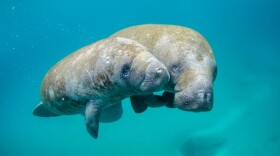-
Nearly 2,000 manatees died in the state in 2021 and 2022, a two-year record. Widespread water quality problems and seagrass losses left the sea cows starving.
-
The judge said the Florida Department of Environmental Protection needs to seek what is known as an “incidental take permit” from federal wildlife officials to help minimize the effects of discharges on manatees.
-
Rampant pollution caused manatees to starve. Florida waters are getting worse.
-
Florida's manatees will likely remain a threatened species. Federal environmental regulators won't recommended increasing their protections as an endangered species.
-
A report from the Florida Fish and Wildlife Commission shows Lee, Brevard and Citrus counties lead the state in manatee deaths through Feb. 14.
-
Nearly 1,000 manatees gathered at Blue Spring State Park in Volusia County on one of the coldest winter days of the season. Here's why the growing number of manatees at the park is encouraging.
-
Over 1,000 Florida manatees died in 2021. That number is the peak in the current unusual mortality event.
-
Nutrient buildup from runoff, increased development and septic systems have led to harmful algal blooms in Indian River Lagoon. These blooms then decimate the seagrass, which is the manatee’s food source.
-
Wildlife officials say a two-year experimental feeding program for starving Florida manatees will not immediately resume this winter as conditions have improved for the threatened marine mammals and the seagrass on which they depend.
-
It is Manatee Awareness month in November, poignant in particular in Lee County, which leads Florida with more than 100 sea cow deaths so far this year.
-
Nearly 2,000 manatees died in Florida in 2021 and 2022 as water pollution killed the seagrass they feed on. The manatee was downlisted in 2017 from endangered to threatened, over the objections of scientists, environmentalists and citizens.
-
Water quality and seagrass health play a big role in marine mammals’ survival anywhere in the state.
Play Live Radio
Next Up:
0:00
0:00
Available On Air Stations











